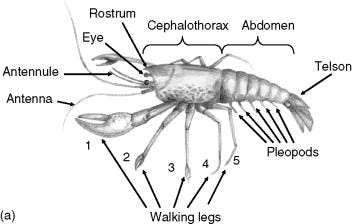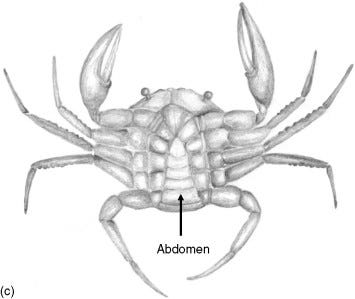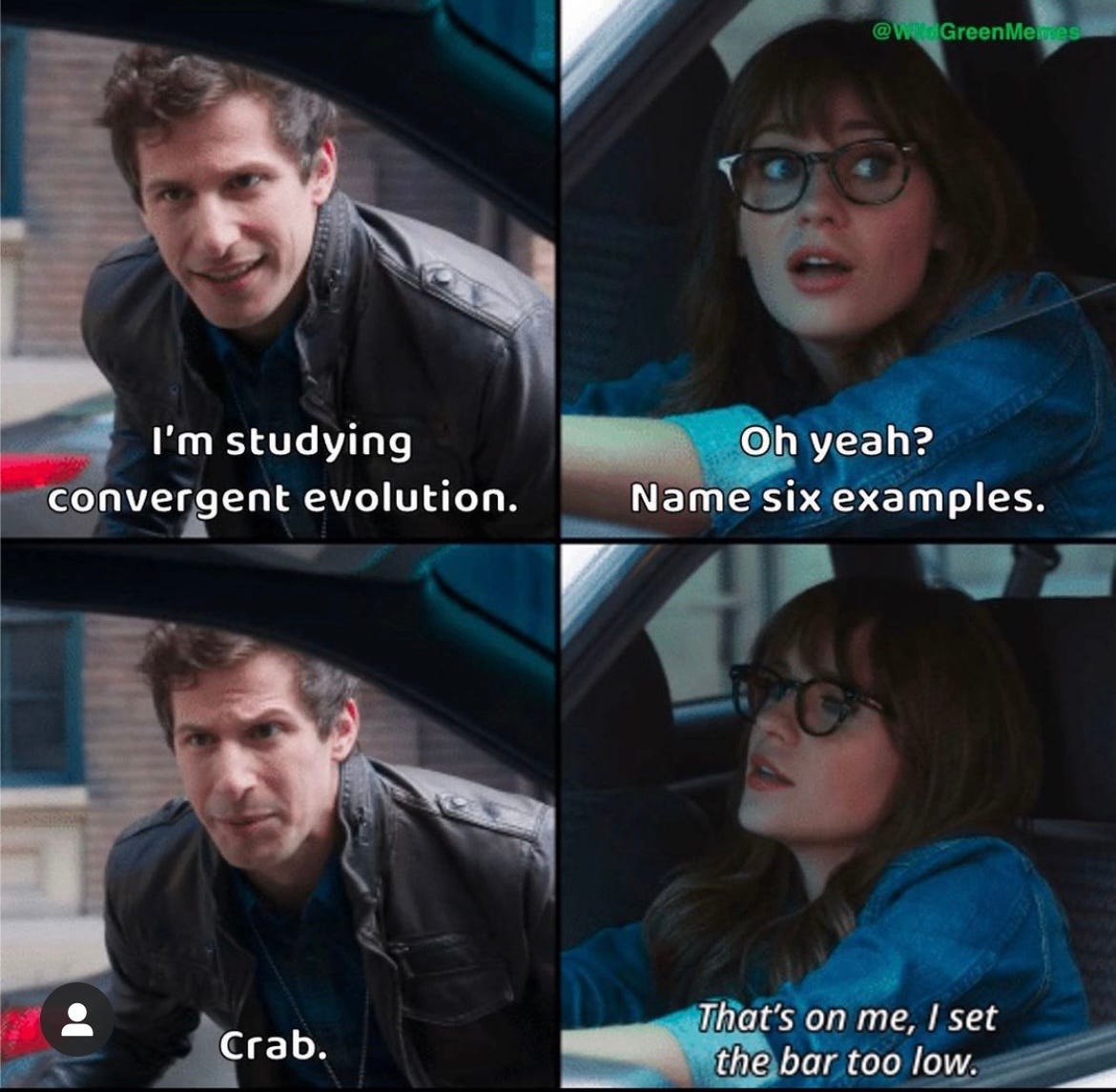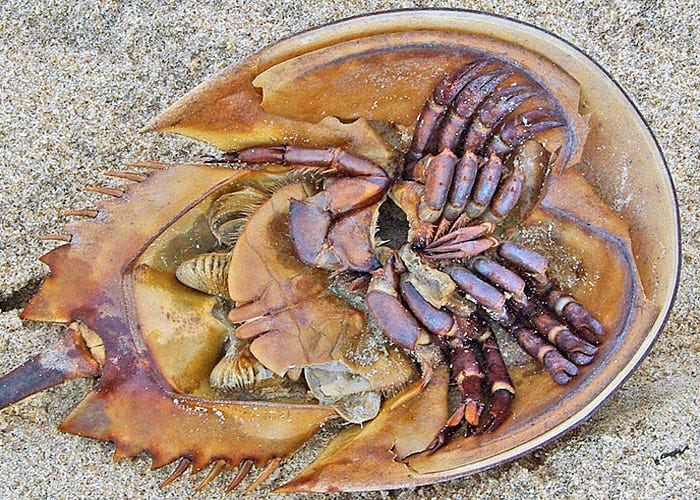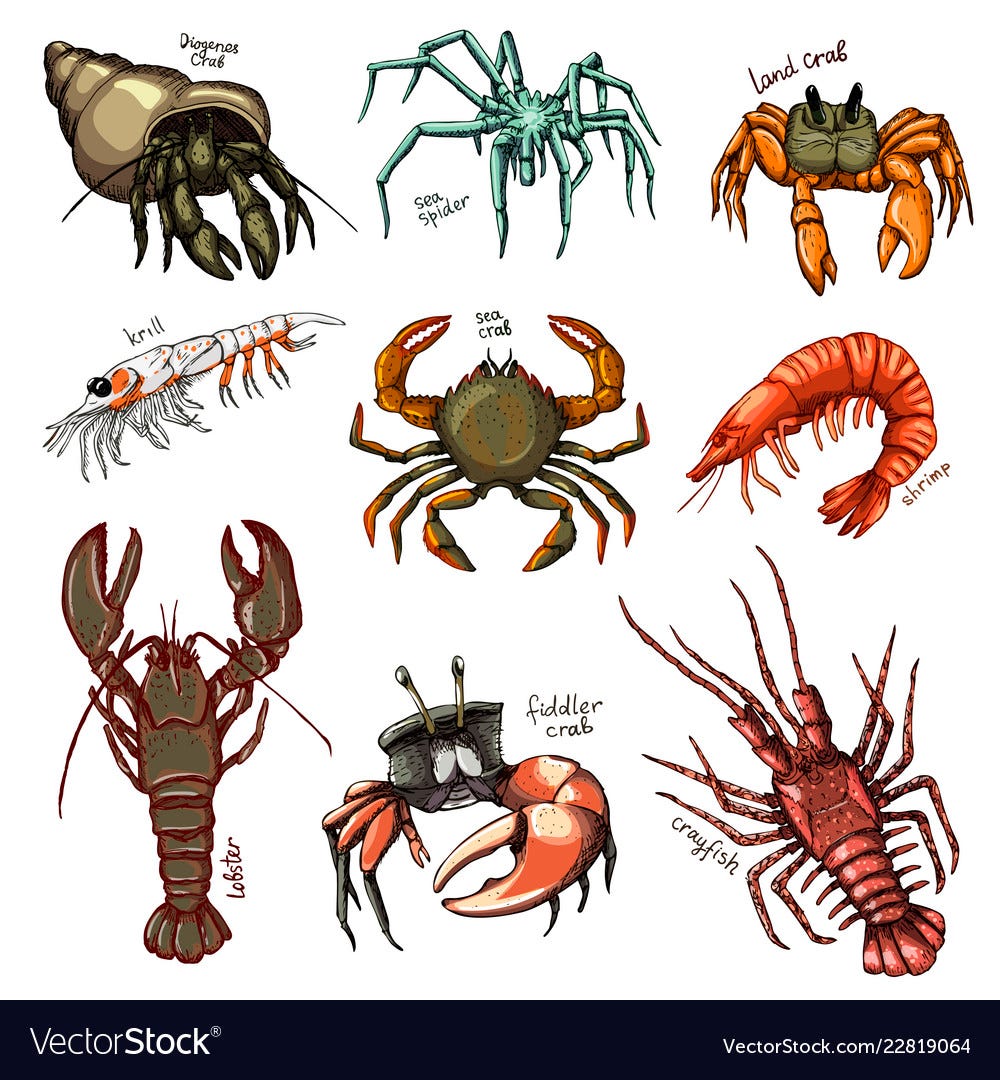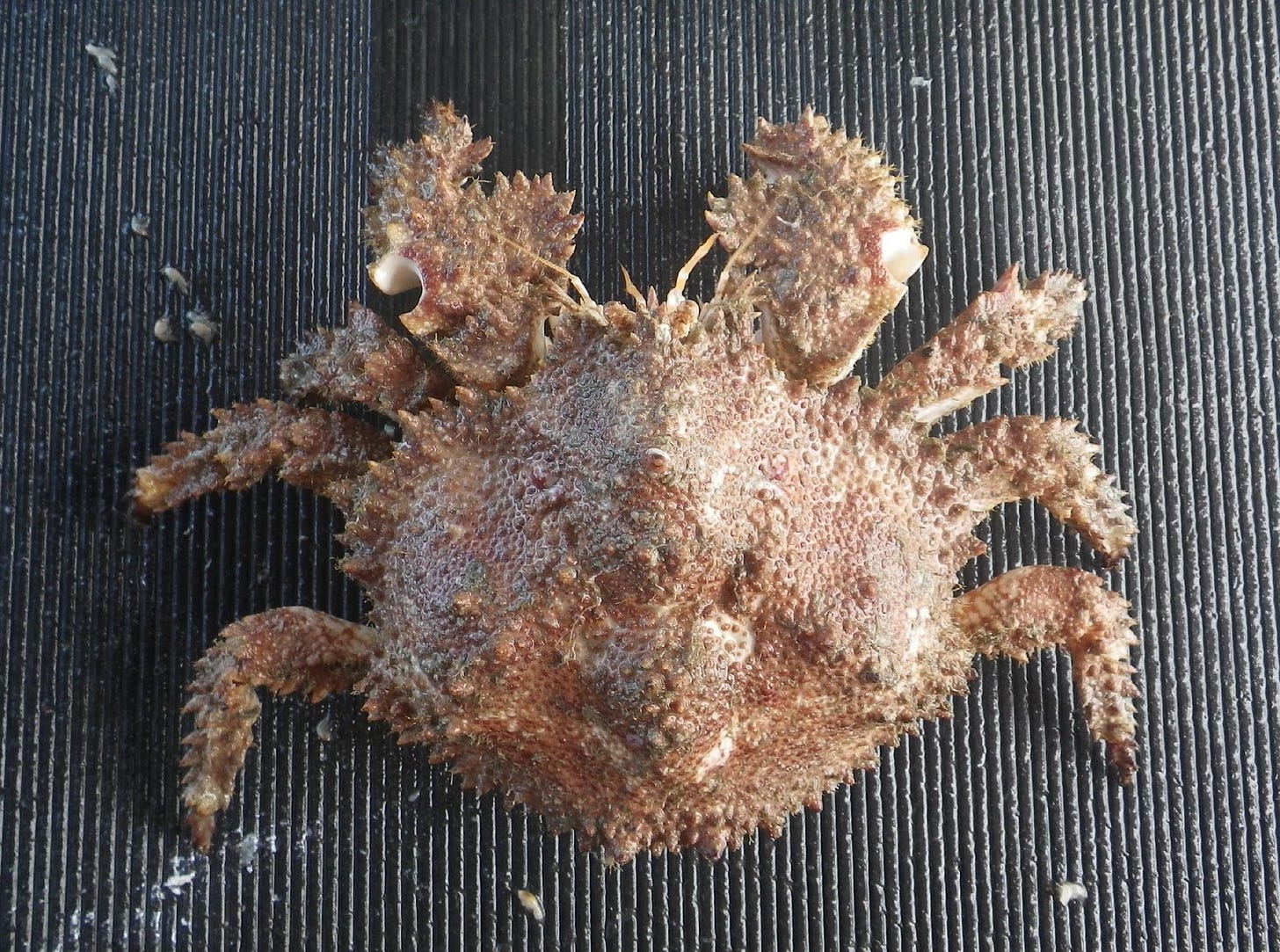I am unfortunate enough to have glanced, just briefly, into the eyes of the universe. Cthulhu is calling. He is the past, the future—all that ever was and all that ever will be—and in him, all that can be seen is…
Crabs.
Maybe someday we really will all evolve into crabs. Or maybe, I’m just being dramatic (that certainly wouldn’t be out of character). To convince you that “crab” is the best way to be a crustacean, I’d like to take you with me on a journey through the past, present, and future of carcinisation: the evolution of distantly related crustaceans into the elite crab form.
Way back in the early Jurassic period, almost 200 million years ago, dinosaurs were beginning to rule the land and the sea—big, hulking monstrosities, some covered in feathers?? Whatever they looked like, it really doesn’t matter. This isn’t their story.
In the ocean, new life is forming. New life that would someday take the world by storm. Emerging into the world is the first crab, the first of many. Its body is strangely shaped, with a wide carapace, four legs for walking, two pinchy claws just waiting for fingers to evolve, and a feeling. A feeling of anticipation and wonder of the world. This is the crab’s coming of age story.

This momentous time in history marks the first expansion of the crustacean into three separate forms: the shrimp, the lobster, and the crab. There is likely an image popping into your brain for each of these forms, but do you know what makes a crustacean a crustacean?
It's only obvious—a penchant for evil.
Oh, and an exoskeleton, the hard part that you break with your crab crackers. But even worse is what they actually do with that exoskeleton. Kind of like getting your period each month, crustaceans (and all arthropods for that matter) undergo periodic molting. Picture this; the crab’s carapace breaks open, exposing the new soft, squishy body underneath. First the new carapace, then one leg at a time, a crab will pull itself out of the old shell. What is left behind is called the “exuvia.”
Isn’t that metal as fuck??
Fun fact, this “new year, new me,” newly molted crab is what we now call a “soft shelled crab.” No silly, it’s not an actual species of crab. Go tell the world you little newly minted crab-expert ;)
But after molting, the crab’s job is not done; just like me on a Friday night, it must pump itself full of fluids. Crabs can use those fluids to grow larger before their exoskeleton hardens yet again.
I think I’ve alluded pretty heavily that molting is an important process for growth, and all crustaceans partake in it. The crabs, lobsters, and shrimp of the world all molt—it’s a normal process (just like periods and blah blah blah). The crustaceans also share similar body plans. They all have 2-3 of what we call tagmata, or distinct body regions, including a head, thorax (or cephalothorax, AKA head and thorax combined), and abdomen—but I like to call this last one their “booty” ;)
While other crustacean forms and arthropods like insects typically show off their booty (I don’t know if you’ve seen a lobster swim but DAMN can they bust it down), crabs are not like the other girls. They don’t go clubbing or to frat parties; instead they hide their crabdomen (no that’s not a real term, I’m just a genius) on the underside of their body.
But the first crab came about in the Jurassic period, and the first insect was waaaay before that, sometime in the early Devonian period. So what makes crabs, and other crustaceans, different from insects?
Well, I’ve got something to admit. It’s because all crustaceans are bi. I wish I meant part of the LGBTQ+ community (you never know though, I’ve been around a lot of crabs and I’ve gotten some vibes), but I really mean that the difference boils down to their legs. The main difference between crustaceans and insects, other than the fact that crustaceans dominate the ocean while insects dominate the land (and I guess most insects have wings or whatever), is that crustaceans have legs that are “biramous,” or branched. Insect legs are not branched, so instead, they are called “uniramous.”
Now that you know so much about crustaceans, I can finally get to the fucking point. Right?
Wrong.
We’ve barely brushed the surface of crab history. While the Jurassic was when the crab form first appeared, it wasn’t until the Cretaceous that crabs really went off (and the dinosaurs went extinct). This was the Crab Revolution™
Okay so, I’m not suggesting that the explosion of crabs led to the downfall of the dinosaurs; all I’m saying is that it’s real suspicious that the dinosaurs went extinct during the same time period that crab diversification became exponential.
In fact, they multiplied so much that some species even underwent decarcinisation, evolving away from the crab shape into something even… stranger. Needless to say, most of those unfortunate species went extinct. But the crab form persevered.
And it didn’t JUST persevere; it thrived. Suddenly, everyone got jealous of crabs (no, they weren’t like you, they didn’t peak in high school). So much so that other species of crustaceans started trying to copy them.
They were so good at copying them that many eventually looked just like crabs. Now, we know that crabs have evolved separately at least five times. But we also know how to tell a real crab from a fake.
The true crabs are all descendents of that first crabcestor (too much?) from the Jurassic period. They’re called Brachyuran crabs (in the infraorder Brachyura, under the order Decapoda, meaning “10-legged'').
Then there’s the fakes; the plastic surgery, off brand cereal, counterfeit yeezy’s; henceforth referred to as the “krabs.” Most of these are the Anomuran crabs (infraorder Anomura, order Decapoda). We tend to lump these imitation krabs (no not the sushi) into this group, like the hermit crabs, king crabs, porcelain crabs, etc. They share some similarities, but really they all interpreted the concept of “crab” a little differently.


And then there’s the horseshoe crab. Don’t get me started on those MFers. Those are basically the Mark Zuckerbergs of the invertebrates; just like how Zucky is DEFINITELY a lizard in a man suit (goodbye besties, I’m probably going to get banned for saying that), horseshoe crabs wear a crab-like disguise. They thought they had us all fooled, but they aren’t even crustaceans! Horseshoe crabs are the least crusty of the krabs.
Out of the crustacean crabs, the Brachyurans and Anomurans (crabs and krabs if you will), can be difficult to tell apart if you don’t know what to look for. Again, it comes down to the legs (is it just me or do arthropods have a thing for legs?). Along with the pair of claws that all crabs have, Brachyurans have four visible walking legs on each side of the body, while Anomurans only have three. They’re still decapods so they do have a fifth set of legs, but they’re so wimpy and small that the Anomurans decided to hide them.
Some Anomurans are even quirkier than others and can easily be distinguished, like the hermit crabs. They are very strange krabs; their curled bodies and thin exoskeletons allow them to wind their abdomens inside dead snail’s shells. The hermit crab-form is thought to be ancestral to another group of Anomuran crabs, the king crabs, who also previously had that spiral-shaped butt.
So why did so many crustaceans (and the horseshoe crabs) evolve to the crab-form? My guess, and the rest of the internet’s, is that life is just better when you’re a crab. Evolutionary biologists have hypothesized that there is an evolutionary advantage to having a crab-like body plan (no, really? I thought they became crabs for no reason /s).
If I haven’t given you enough proof that the crab-form is the best, then I doubt I’ll change your mind now. But there does seem to be a strong advantage to being a crab. Maybe it’s easier for crabs to colonize new habitats. Or become new species. Maybe crabs are better at ditching their predators than other crustaceans. There’s a reason why there are over 7,000 species of Brachyurans and 2,500 species of Anomurans (and only four horseshoe crab species? What’s up with that). And the reason is obvious:
To crab is to be God-Tier.
The crab-form is obviously elite. But even though I’ve spent this entire time trying to convince you of this, I will bring in a counterpoint; crabs are not the only crustaceans that have fake versions of themselves. In fact, each of the three main body plans of crustaceans have their own generic versions. There are true lobsters and fake lobsters, true shrimp and fake shrimp. So I offer you this; perhaps not JUST the crab-form is elite, but all crustacean body plans.
If it’s so great to be a crustacean, then what does our future look like? Will everything eventually become a busty crustacean? I applaud you if you’re not at least slightly terrified. While the thought of having two massive claws that I can use to trim trees or my ex’s gnards does slightly excite me, I think I’d rather remain a biped.
We can only wait and see what the future has in store for us. And when the crabs ultimately decide to overrun human society, taking over our governments, forcing us to live the crab-lifestyle; they will wholeheartedly shellibrate our downfall.
Live, Laugh, Leviathan!
SPECIES HIGHLIGHT
Brown Box Crab
Lopholithodes foraminatus
Now, I’m going to be a bit shellfish here (I know I basically just made the same pun twice, let me have this) and talk about a crab species that I personally did research on at UCSB with the Culver lab and the California Sea Grant.
Brown box crabs are a type of king crab, meaning they are also Anomurans, or false crabs. These guys were previously only caught as bycatch but there is now an up-and-coming experimental fishery along some areas of California’s coast. They’re pretty tasty; I would know as I have killed and eaten my fair share of them in the lab.

They’ve got a really interesting purple-brown color to them and are covered in small spines. Their range extends from Alaska to San Diego, California and they are usually found in water deeper than 18 meters (59 ft).
Other than that, and a bit of boring stuff about their life cycle, we don’t know much about them. That’s why there isn’t an established fishery for them yet. In order for a full-blown fishery to begin, we need to figure out a lot more about their life history and use that information to create a fishery management plan. The California Sea Grant is working with labs like mine as well as fishermen with permits to catch them to gather this information so that you too can someday taste the delicious, decadent brown box crab.
NEWS AND RESOURCES
Some California crab fishery news
California Department of Fish and Wildlife: CDFW Announces Closure Of Commercial Dungeness Crab Fishery Off Central California To Protect Humpback Whales
Cool crab stuff
Science Magazine: Crabs feel pain
SciTechDaily: First Dinosaur Era Crab Discovered – Fully Preserved in 100-Million-Year-Old Amber
Other articles on carcinisation
Newsweek: Animals Keep Evolving Into Crabs, and Scientists Don't Know Why
Popular Science: Why everything eventually becomes a crab
My favorite meme page
Instagram: Wild Green Memes
Facebook: Wild Green Memes for Ecological Fiends
Your next religion?
Plans to create and worship our leviathan lobster god
Internship opportunities at UCSB
The UCSB REEF (Research Experience and Education Facility)
UCSB’s touch tank aquarium staffed by undergraduates! I worked here as a volunteer, then a paid intern, then an aquarist and lead informal science educator
Learn about temperate marine organism husbandry, the marine science research going on at UCSB, and education skills for K-12th grade and beyond!
Instagram and TikTok (both feature me so go check it out, no balls)
Do crabs interest you? How about aquaculture or fisheries? This is a small invertebrate aquaculture and fisheries lab that I work in at UCSB
Works with UCSB undergraduates, recent graduates, and Master’s students
Current research is on crab and lobster toxicology, as well as giant rock scallop aquaculture practices






